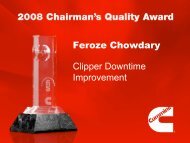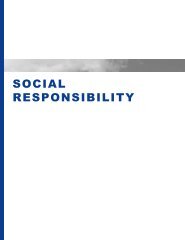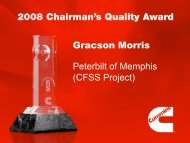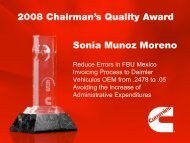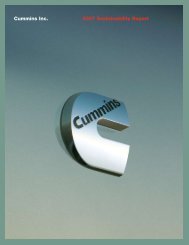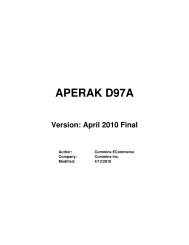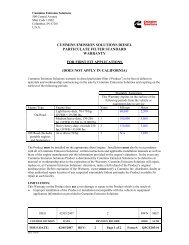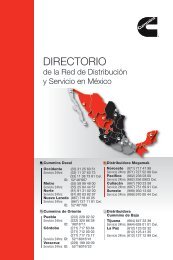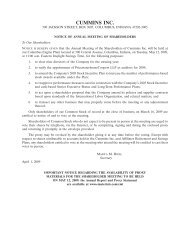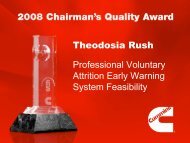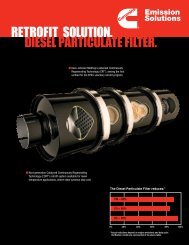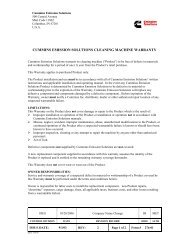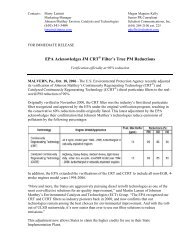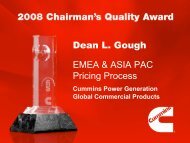Cummins Inc. 2007 Sustainability Report
Cummins Inc. 2007 Sustainability Report
Cummins Inc. 2007 Sustainability Report
Create successful ePaper yourself
Turn your PDF publications into a flip-book with our unique Google optimized e-Paper software.
“We believe the<br />
right technology<br />
matters and<br />
that nobody is<br />
better than we<br />
are at creating<br />
emissions-compliant<br />
products that meet<br />
our customers’<br />
expectations.”<br />
Virendra Kumar<br />
and system integration. Our Tier 4 solution<br />
is driven by the need to deliver the lowest<br />
cost of ownership and most productive<br />
power solutions for operators. The 2011<br />
off-highway regulations require a 90 percent<br />
reduction in PM and a 45 percent reduction<br />
in NOx emissions.<br />
While meeting these stringent reductions,<br />
<strong>Cummins</strong> Tier 4 QSB to QSX products will<br />
offer enhanced performance and improved<br />
fuel efficiency compared to our current<br />
Tier 3 engines.<br />
Integrating Tier 4 engine and aftertreatment<br />
into a wide variety of off-highway equipment<br />
types will be challenging, but <strong>Cummins</strong>’<br />
application engineering expertise will enable<br />
us to design and pre-engineer all the key<br />
subsystems in-house.<br />
For Tier 4, <strong>Cummins</strong> will offer standardized<br />
engine, aftertreatment and air intake<br />
packages, speeding up installation work<br />
and realizing space-saving advantages for<br />
our OEM customers.<br />
The 2010 EPA Emissions<br />
and Fuel Rule<br />
Looking ahead to 2010, emission<br />
requirements will change dramatically for<br />
heavy-duty trucks over this period. Both<br />
NOx and PM will be reduced by 90 percent<br />
from 2004 levels.<br />
The EPA has allowed for a NOx phase-in<br />
from <strong>2007</strong> through 2009. During this time,<br />
50 percent of the engines produced must<br />
meet the stricter, <strong>2007</strong> NOx standard,<br />
while 50 percent may continue to meet the<br />
2004 standard.<br />
The PM requirement was not phased in,<br />
and, as a result, all engine production was<br />
42 <strong>Cummins</strong> <strong>Inc</strong>. <strong>2007</strong> <strong>Sustainability</strong> <strong>Report</strong><br />
required to be in compliance with the new<br />
standard by January of <strong>2007</strong>.<br />
By 2010, all heavy-duty diesel engines<br />
are expected to meet the NOx standard of<br />
0.20 grams per brake-horsepower hour<br />
(g/bhp-hr) and the PM standard of<br />
0.01g/bhp-hr.<br />
Also by 2010, regulations will require the<br />
phase-in of advanced on-board diagnostics<br />
with additional sensors to monitor the<br />
effectiveness of emission-control systems<br />
on the engine, which will alert the driver if a<br />
failed emission-reduction device needs to<br />
be repaired.<br />
Ultra-Low Sulfur Diesel Fuel (ULSD)<br />
In addition to the new exhaust emission<br />
standards, the EPA is lowering the limit for<br />
diesel sulfur fuel from 500 parts per million<br />
(ppm) to 15 ppm. The new fuel standard<br />
began to be phased in October 2006 and<br />
will be completed by September 1, 2010<br />
(100 percent participation).<br />
<strong>Cummins</strong> has publicly expressed its<br />
support of ultra-low sulfur fuel. ULSD<br />
has several benefits. It produces less<br />
particulate matter from combustion, so it<br />
is a particulate matter control strategy for<br />
all equipment in use. In addition, ultra-low<br />
sulfur fuel enables the use of advanced<br />
aftertreatment control systems.<br />
Biodiesel Fuels Now in Use<br />
Biodiesel is a clean-burning alternative<br />
fuel made from renewable resources like<br />
soybeans, vegetable oils and even algae.<br />
It creates about 60 percent less carbon<br />
dioxide than petroleum fuels, biodegrades<br />
as quickly as sugar, and is less toxic than



